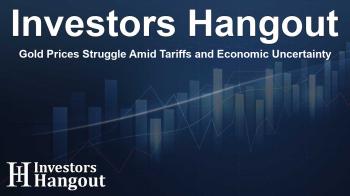Gold Prices Struggle Amid Tariffs and Economic Uncertainty

Gold Prices Decline Amid Market Uncertainty
Gold prices have been under significant pressure recently as various economic factors converge to create a challenging environment for investors. The recent decision by President Trump to extend tariffs on specific imports has led to heightened uncertainty in the markets. The market's reaction to this news indicates a shift in how investors are perceiving gold, which is often viewed as a safe haven in times of economic distress.
The Impact of Tariff Extensions on Market Stability
The notification regarding the tariff extensions has sparked immediate concerns among traders and investors. This has led to noticeable sell-offs across global markets, with gold being no exception. Despite its usual appeal during times of market turbulence, the demand for gold appears to have waned as investors assess the implications of the tariff decision. The ongoing trade issues, particularly between the US and China, have left many uncertain about the future direction of both economies.
Changing Sentiments Regarding Monetary Policy
In addition to market volatility, shifting sentiments regarding monetary policy are weighing down gold's appeal. Recent economic data have pointed to a stabilizing US economy, causing many investors to reduce their expectations for aggressive interest rate cuts by the Federal Reserve. Earlier in the year, substantial rate cuts were anticipated as a reaction to economic challenges. However, with positive indicators emerging, those expectations have diminished, thus impacting gold's attractiveness.
Gold vs. Alternative Safe-Haven Investments
As gold's price declines, other safe-haven assets such as the US dollar and government bonds have become increasingly favorable. With dwindling expectations for rate cuts, the dollar has grown more appealing, drawing investors away from gold. Bonds now represent more stable investments in this climate of uncertainty, leading to a shift away from precious metals.
What Lies Ahead for Gold Prices?
The future remains unpredictable for gold in light of ongoing trade tensions and potential shifts in US economic policy. As these global uncertainties linger, gold may continue to serve as a valued asset. However, its price might experience fluctuations lacking any reinforcing catalysts in the immediate term. Should escalating trade wars prompt further investor interest in safe havens, gold could regain traction, although improving trade relations might keep prices subdued.
The market also remains sensitive to any signals from the Federal Reserve regarding interest rate policies. Any indication of a dovish shift from the Fed could revive interest in gold, while maintaining stable rates without significant cuts could further challenge its recovery.
Conclusion: Coping with Economic Pressures
The recent downturn in gold prices highlights the unique intersection of trade tensions and evolving monetary policies. While still retaining its designation as a haven for investors, the ongoing tariff extensions alongside decreased rate cut expectations may continue to challenge its stability. With market participants eagerly awaiting clarity on trade negotiations and the Fed's next moves, the price trajectory for gold remains uncertain and potentially volatile.
Frequently Asked Questions
1. Why are gold prices declining recently?
Gold prices are declining due to increased market uncertainty stemming from tariff extensions and diminishing expectations for significant rate cuts by the Federal Reserve.
2. What are the main factors affecting gold demand?
The main factors include global trade tensions, changing sentiments regarding US monetary policy, and competition from alternative safe-haven investments like the US dollar and government bonds.
3. Can gold prices rebound in the near future?
While the potential for a rebound exists, it largely depends on developments in global trade relations and signals from the Federal Reserve regarding interest rates.
4. What alternatives are investors considering instead of gold?
Investors are increasingly favoring the US dollar and government bonds due to their stability in an uncertain economic environment.
5. How do changes in US monetary policies influence gold?
Changes in US monetary policies, especially interest rate expectations, significantly impact gold prices, as lower rates typically bolster gold demand while higher rates do the opposite.
About The Author
Contact Evelyn Baker privately here. Or send an email with ATTN: Evelyn Baker as the subject to contact@investorshangout.com.
About Investors Hangout
Investors Hangout is a leading online stock forum for financial discussion and learning, offering a wide range of free tools and resources. It draws in traders of all levels, who exchange market knowledge, investigate trading tactics, and keep an eye on industry developments in real time. Featuring financial articles, stock message boards, quotes, charts, company profiles, and live news updates. Through cooperative learning and a wealth of informational resources, it helps users from novices creating their first portfolios to experts honing their techniques. Join Investors Hangout today: https://investorshangout.com/
The content of this article is based on factual, publicly available information and does not represent legal, financial, or investment advice. Investors Hangout does not offer financial advice, and the author is not a licensed financial advisor. Consult a qualified advisor before making any financial or investment decisions based on this article. This article should not be considered advice to purchase, sell, or hold any securities or other investments. If any of the material provided here is inaccurate, please contact us for corrections.

